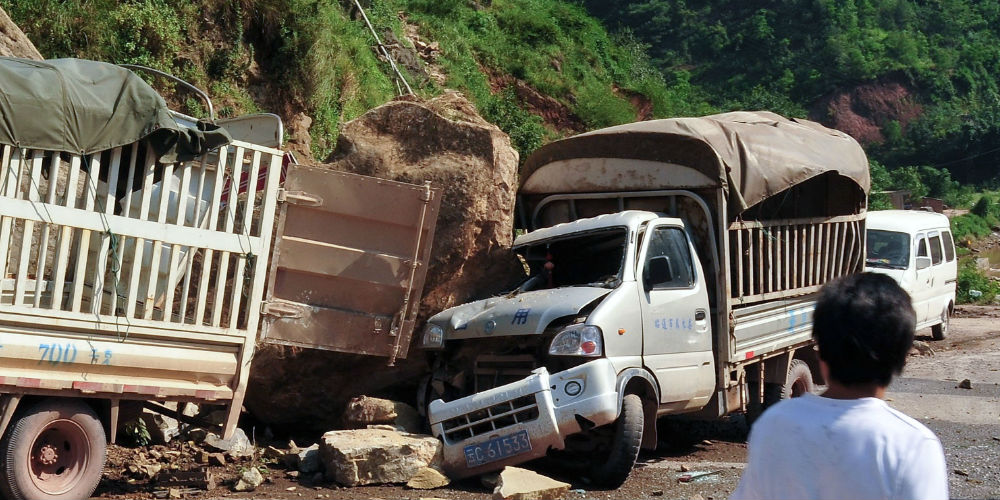
A man looks at the trucks damaged by fallen rocks after an earthquake in Zhaotong town, Yiliang County, southwest China’s Yunnan Province, Friday, Sept. 7, 2012. A series of earthquakes collapsed houses and triggered landslides Friday in a remote mountainous part of southwestern China where damage was preventing rescues and communications were disrupted. At least 64 deaths have been reported. AP
BEIJING — Blocked mountain roads were hampering rescue efforts after twin earthquakes struck southwestern China and killed at least 80 people, leaving officials worried Saturday that the death toll could rise further.
More than 100,000 residents were evacuated after Friday’s quakes toppled thousands of houses and sent boulders cascading across roads in a remote mountainous area along the borders of Guizhou and Yunnan provinces.
The damage was preventing rescuers from reaching outlying towns, and communications were disrupted after the midday quakes hit in a region of small farms and mines where some of China’s poorest people live. Weather forecasts Saturday said there was a chance of rain over the next three days, which could hamper rescue work.
But there was some good news, with state television reporting that four babies had been born in temporary hospitals set up since the quakes hit.
The first magnitude-5.6 quake struck just before 11:30 a.m. Friday and was followed by an equally strong quake shortly after noon, joined by dozens of aftershocks. Though of moderate strength, the quakes were shallow, which often causes more damage.
The state-run Xinhua News Agency said Saturday that 80 people had died in the quakes. It said earlier that hundreds had been hurt, but did not immediately give a new injury toll Saturday.
Hardest hit was Yiliang County, where all but one of the deaths occurred, according to the Yunnan provincial government’s official website. Another 730 people in the area were injured, Xinhua said. Yiliang’s high population density, flimsy building construction and landslide-prone hillsides were blamed for the relatively high death toll.
China Central Television showed roads littered with rocks and boulders and pillars of dust rising over hilltops from the landslides. One image taken just as one quake struck showed people running out of a supermarket as the ground shook.
Other footage showed villages of blue tents being set up for the evacuated, as well as hundreds of people crowding into a school athletic field in Yiliang’s county seat, a sizable city spread along a river in a valley.
Though quakes occur in the area frequently, buildings in rural areas and China’s fast-growing smaller cities and towns are often constructed poorly. A magnitude-7.9 quake that hit Sichuan province, just north of Yunnan, in 2008 killed nearly 90,000 people, with many of the deaths blamed on poorly built structures, including schools.
Xinhua quoted Yunnan’s civil affairs department as saying Friday’s quakes destroyed 6,650 houses and damaged 430,000 others. Besides the 100,000 residents already evacuated, another 100,000 were in need of relocation, the department said.
“The hardest part of the rescue will be handling traffic,” Li Fuchun, head of Luozehe township in Yiliang, was quoted as saying by Xinhua. “Roads are blocked and rescuers have to climb mountains to reach hard-hit villages.”
That included a village near a zinc mine in Luozehe. “It is scary. My brother was killed by falling rocks,” miner Peng Zhuwen told Xinhua. “The aftershocks struck again and again. We are so scared.”
The government has sent thousands of tents, blankets and containers of water into the area, and the Red Cross spokesman for East Asia, Francis Markus, said 2,000 quilts, 2,000 jackets and 500 tents were being rushed to the area, which is largely inhabited by members of the Yi ethnic minority.
He said the use of light construction materials would likely create far more injuries than deaths.
A government official in Jiaokui town said a large number of houses had collapsed.
“The casualty number is still being compiled. I don’t know what it was like for the other towns, but my town got hit badly,” he said. Like many Chinese officials, he refused to give his name.
Mobile phone services were down and regular phone lines disrupted. Phones were cut off to clinics in four villages in Qiaoshan, another town in Yiliang, which has about half a million people.
Authorities sent thousands of tents, blankets and coats to the area, Xinhua said.
It said that so far no deaths had been reported in neighboring Guizhou, but that homes had been damaged or destroyed there.
Friday’s quakes were relatively shallow, about 10 kilometers (six miles) deep, creating an intense shaking even at a lower magnitude.
By comparison, the magnitude-7.6 quake in Costa Rica this week was 40 kilometers (25 miles) below the surface, a fact that, combined with strict building codes, kept damage and deaths to a minimum.
Originally posted: 10:00 am | Saturday, September 8th, 2012